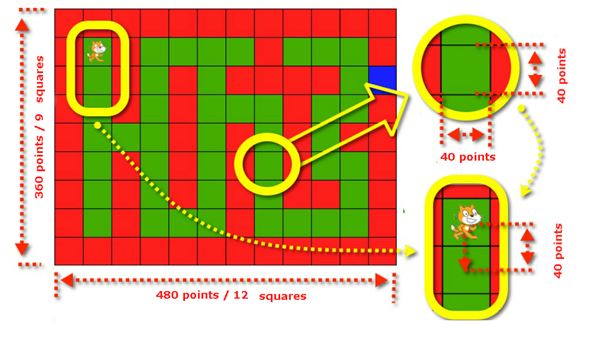Module 3 - The “Cat in a Maze” Project
These materials have been developed by Ośrodek Edukacji Informatycznej i Zastosowań Komputerów (Centre for Information Technology Education and Application of Computers) in Warsaw as part of the “Mistrzowie Kodowania” (“Coding Masters”) Programme funded by Samsung Electronics Polska, licensed under CC-BY-SA “Attribution – Share Alike 3.0 Poland”
Spis treści
Information
Objectives
General objectives:
- Review and revision of previously presented Scratch commands and language structures.
- Development of a simple maze game project.
- Implementation of the game in the Scratch environment.
Specific objectives:
- The student will learn to construct simple scripts that respond to pressing a key.
- The student will understand and know how to use the conditional instruction and the loop instruction.
- The student will be able to control the behaviour of a sprite based on its location.
- The student will be able to change and edit the stage background.
- The student will be able to implement a sprite’s behaviour on a project basis.
Preparation before the class:
Before the class the students receive a file with a background (a ready maze board) for the Cat in a Maze game. Before the lesson we load it to computers in the students’ stations.
Stages
Discussion of solutions to selected module II additional tasks
Time to complete this part: about 15 minutes
At the beginning of the lesson we remind students what they were supposed to prepare between classes. We invite a volunteer to present his/her solution. We discuss with the students if anyone solved the task in a different way. We discuss the solutions (we praise each correct solution to a task).
If there was no homework, we start by reviewing key issues from the previous module. We also ask if students have any doubts about their own projects. If any students want to, we let them present something they are proud of.
Designing a game involving going through a maze
Time to complete this part: about 20 minutes
We suggest the development of a new game during the lesson. This time the purpose of the game will be for our character to successfully get through a maze. We will begin by planning how the game should run.
Together with the students on the board we draw a rectangle, inside there is a simple maze with only one exit. We fill in anything that is not the path inside the maze with a specified colour (e.g. red). We use another colour (e.g. blue) to mark the exit. We colour in the maze path e.g. with green. We put our character in a place (square) opposite the exit (marked with a different colour – blue in our example). The sketch of the maze should be similar to the picture below.
We begin the discussion of how we should describe the behaviour of the character (sprite), and how we are going to control it:
Question: With what should the game start after it is initiated?
There may be various suggestions. We should prompt the students that our character should be placed in the middle of the starting square. It should be noted that the sprite character should entirely fit in a single maze square, so as not to touch its walls.
Question: How will we control the character?
What button are we going to use to make our character go forward? Should it move forever?
– We guide the students to find the answer “No,” because it will collide with a maze wall.
How many steps should it now take?
– Enough to move from one square to the next, adjacent one. We discuss what this means, pointing to the maze drawing on the board. Together we reach the conclusion that the character should move forward a number of steps that is equal to the length of the side of a single field in our maze.
In this case, should we choose to control the character with the computer mouse or the keyboard?
– In this game it will be easier to control the character using the keyboard.
After discussing which key should make the character move by one square, we write on the board what we have agreed on, for example:
* When the up arrow key is pressed, go forward by “one square.”


